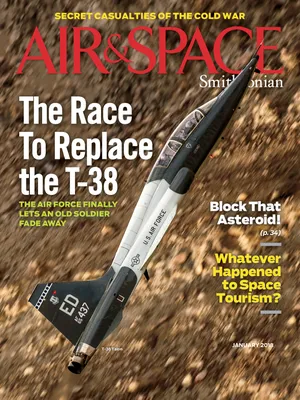Air Turbulence Will Likely Get Worse as the Planet Warms
Buckle up, it’s getting hot out there.
/https://tf-cmsv2-smithsonianmag-media.s3.amazonaws.com/filer/7c/ea/7ceadd97-0288-4c61-9d7c-d00d024bdfdf/24j_dj2018_turbulence_spot_live.jpg)
Hurricanes, droughts, wildfires, and heat waves—they’re all expected to grow more intense and frequent as the global climate warms. Now you can add inflight air turbulence to the list.
A recent U.K. study suggests that clear-air turbulence—the kind that can strike airliners without warning at high altitudes—will intensify dramatically during the second half of this century because of climate change.
“Future passengers can expect the seatbelt sign to be switched on a lot more often,” says Paul D. Williams, professor of atmospheric science at the University of Reading and the study’s lead author.
The study builds on previous work suggesting that clear-air turbulence, also known as CAT, will increase as the atmosphere warms. Using a climate model from the Met Office Hadley Center, where scientists have been studying atmospheric dynamics since the 1950s, Williams and his colleagues simulated how projected warming between 2050 and 2080 would influence vertical wind shear in the upper troposphere and lower stratosphere. The researchers looked at how various strengths of CAT could change around the planet, at various flight altitudes, and during all four seasons. “We’ve now seen the same turbulence increases in multiple computer models,” says Williams. “Furthermore, we understand physically which mechanisms are driving the turbulence increase, so this is not just a computer modeling result.”
The globe’s busiest airways will experience the largest increases in severe turbulence, the study suggests. “CAT is mainly generated in the jetstream…[and] at flight cruising altitudes, the jetstream in those middle latitudes is becoming more sheared because of climate change,” Williams says.
Aircraft technology for detecting turbulence is improving, though perhaps not at the rate needed. LIDAR (light detection and ranging) equipment, which uses light waves rather than radio waves, can detect CAT up to about 15 miles ahead, Williams says. But LIDAR instruments are not yet available for airliners. In the meantime, commercial aircraft manufacturers designing tomorrow’s jetliners—as well as the passengers who will ride in them—should prepare for a bumpier future.
/https://tf-cmsv2-smithsonianmag-media.s3.amazonaws.com/accounts/headshot/Bruce_Lieberman_Yosemite_Cropped.jpg.jpeg)

/https://tf-cmsv2-smithsonianmag-media.s3.amazonaws.com/accounts/headshot/Bruce_Lieberman_Yosemite_Cropped.jpg.jpeg)